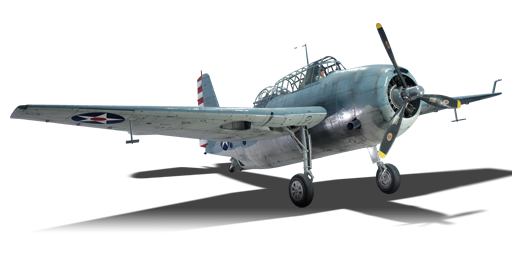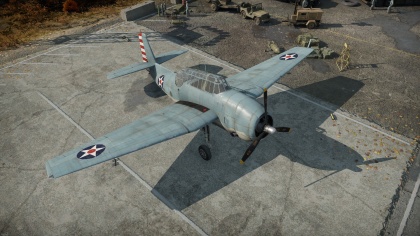Difference between revisions of "TBF-1C"
(→History: Added in-game description) |
|||
| Line 305: | Line 305: | ||
* [https://warthunder.com/en/news/3149/current/ [Vehicle Profile<nowiki>]</nowiki> TBF-1c / Avenger Mk 1] | * [https://warthunder.com/en/news/3149/current/ [Vehicle Profile<nowiki>]</nowiki> TBF-1c / Avenger Mk 1] | ||
| + | {{AirManufacturer Douglas}} | ||
{{USA bombers}} | {{USA bombers}} | ||
Revision as of 19:50, 30 December 2019
Contents
| This page is about the American bomber TBF-1C. For the British version, see Avenger Mk II (Great Britain). |
Description
The TBF-1C Avenger is a rank I American naval bomber
with a battle rating of 1.7 (AB/RB) and 2.0 (SB). It has been in the game since the start of the Open Beta Test prior to Update 1.27.
General info
Flight Performance
Describe how the aircraft behaves in the air. Speed, manoeuvrability, acceleration and allowable loads - these are the most important characteristics of the vehicle.
| Characteristics | |||||||
|---|---|---|---|---|---|---|---|
| Stock | |||||||
| Max Speed (km/h at 3,650 m) |
Max altitude (meters) |
Turn time (seconds) |
Rate of climb (meters/second) |
Take-off run (meters) | |||
| AB | RB | AB | RB | AB | RB | ||
| 414 | 398 | 7100 | 31.1 | 32.4 | 3.2 | 3.2 | 307 |
| Upgraded | |||||||
| Max Speed (km/h at 3,650 m) |
Max altitude (meters) |
Turn time (seconds) |
Rate of climb (meters/second) |
Take-off run (meters) | |||
| AB | RB | AB | RB | AB | RB | ||
| 452 | 432 | 7100 | 29.0 | 30.0 | 7.3 | 5.1 | 307 |
Details
| Features | ||||
|---|---|---|---|---|
| Combat flaps | Take-off flaps | Landing flaps | Air brakes | Arrestor gear |
| X | X | ✓ | X | ✓ |
| Limits | ||||
|---|---|---|---|---|
| Wing-break speed (km/h) |
Gear limit (km/h) |
Combat flaps (km/h) |
Max Static G | |
| + | - | |||
| 485 | ~6 | ~2 | ||
| Optimal velocities | |||
|---|---|---|---|
| Ailerons (km/h) |
Rudder (km/h) |
Elevators (km/h) |
Radiator (km/h) |
| < 300 | < 220 | < 220 | > 318 |
| Compressor (RB/SB) | ||
|---|---|---|
| Setting 1 | ||
| Optimal altitude | 100% Engine power | WEP Engine power |
| 1,768 m | 1,500 hp | 1,684 hp |
| Setting 2 | ||
| Optimal altitude | 100% Engine power | WEP Engine power |
| 3,962 m | 1,350 hp | 1,516 hp |
Survivability and armour
- 6.35 mm Steel - Armour plate in the nose
- 12.7 mm Steel - Armour plate behind the pilot
- 12.7 mm Steel - Armour plate in dorsal gunner's seat
- 12.7 mm Steel - Armour plate in front of dorsal gunner
- 12.7 mm Steel - Armour plate in front of ventral gunner
- 6.35 mm Steel - Armour plate under the ventral gunner
- 40 mm Bulletproof glass in front of dorsal gunner
- 0.1 mm Wood - Connecting ventral gunner's armour
Armaments
Offensive armament
The TBF-1C is armed with:
- 2 x 12.7 mm Browning M2 machine guns, wing-mounted (310 rpg = 620 total)
Suspended armament
The TBF-1C can be outfitted with the following ordnance:
- 4 x 500 lb AN-M64A1 bombs (2,000 lb total)
- 1 х Mk.13 torpedo
- 1 х Mk.13/44 torpedo
Defensive armament
The TBF-1C is defended by:
- 1 x 12.7 mm Browning M2 machine gun, dorsal turret (400 rpg)
- 1 x 7.62 mm Browning machine gun, ventral turret (500 rpg)
Usage in battles
As with all torpedo bombers, maintaining low altitude, high speed, and fighter cover are all recommended. The optimal distance for launching a torpedo is 1 km from the target. Targets should be engaged from directly ahead or astern, making "leading" the target much easier. If torpedo bombing is not an option, the plane can carry bombs for attacking ground targets.
The Avenger lacks much significant armament, but in a pinch it can serve as a fighter. The aircraft is not particularly fast or manoeuvrable, but, continuing the trend among mid-tier American aircraft, is extremely durable.
Fly low and fast, head towards your target, drop your ordinance and bug out. However, if there are no hostile fighters in the area, destroy some enemy ground installations, e.g. AA, light vehicles, landing crafts and anti-tank positions.
Simulator mode procedures
Hands-off carrier take-off (Auto engine control): Start engine, flaps: raised, elevator trim: 0%, aileron trim: 0%, rudder trim: 14% right, WEP throttle, hands off controls until you lift off the carrier.
Level-type carrier landing final approach (Auto engine control): Drop any secondary weapons you may still have, make sure your alignment with the carrier and heading are good for landing, use your stick to hold an altitude of 40 m (120 ft), slow down below 200 km/h (125 mph / 108 kt), elevator trim: 2%, aileron trim: 18%, rudder trim: 0%, after gently slowing down to 123 km/h (77 mph / 67 kt) set throttle to about 55% (you will have to adjust throttle a lot, though), just before the carrier (less than 1 km (0.62 mi)) cut throttle and reset all trim to 0%, landing should be easy after that.
Manual Engine Control
| MEC elements | ||||||
|---|---|---|---|---|---|---|
| Mixer | Pitch | Radiator | Supercharger | Turbocharger | ||
| Oil | Water | Type | ||||
| Controllable | Controllable Auto control available |
Controllable Not auto controlled |
Controllable Not auto controlled |
Separate | Controllable 2 gears |
Not controllable |
Modules
| Tier | Flight performance | Survivability | Weaponry | |||
|---|---|---|---|---|---|---|
| I | Fuselage repair | Radiator | Turret 7 mm | ITC mk.III | ||
| II | Compressor | Airframe | New 7 mm MGs (turret) | Offensive 12 mm | ||
| III | Wings repair | Engine | Turret 12 mm | Improved torpedo | ||
| IV | Engine injection | Cover | New 12 mm MGs (turret) | New 12 mm MGs | ||
- Performance is a secondary criteria for an attacker. The focus should be on improved armament, especially the upgraded torpedoes that make handling them much easier. The machine gun upgrades are not really needed, the normal M2 Browning does well enough. The turrets however profit and gain longer and more accurate fire. Of course performance upgrades do not hurt, Compressor, Engine and Engine Injection should be essential pick-ups, the rest on the other hand can be scheduled to the end of grind.
Pros and cons
Pros:
- Robust construction
- Adaptive secondary ordnance for different maps e.g. naval and ground based operations
- Very good vision from pilot's seat in cockpit
- Great stability
- Good defensive gunner coverage
Cons:
- Limited bomb selection for a bomber
- Wing mounted 12.7 mm machine guns factoring in convergence
- Poor low altitude performance, especially when turning
- Slow
- Touchy controls, tends to over-respond to small control inputs (SB)
- Ventral gunner has little protection, easily knocked out
- Only has landing flaps
History
| Typical Monthly Production | Grumman TBF-1 |
|---|---|
| February, 1942 | 5 |
| June, 1942 | 60 |
| November, 1942 | 100 |
Battle Of Midway - June 4, 1942.
First Combat mission of the TBF-1 was on June 4, 1942 at the battle of Midway. Only six TBF-1 were available, for the start of the battle they were attached to VT-8.
All apart from one were lost.
Eastern Solomons - Aug. 24/25th 1942
Admiral Yamamoto's infamous naval counter-strike 24th of August. The opposing naval forces met; the US Navy had only two carriers: Saratoga (VT-8) and Enterprise (VT-3). The Imperial Japanese Navy (I.J.N) had the carriers: Shōkaku, Zuikaku and a light carrier Ryūjō. By August, TBF's had been delivered to the two ships.
26 TBF-1 Avengers from VT-3 and VT-8 were launched. Their torpedoes helped to sink the light carrier I.J.N. Ryūjō. Seven Avengers were lost.
Santa Cruz - Oct. 26, 1942
Guadalcanal - Nov, 12/13th, 1942
- Sank the I.J.N. Hiei battleship (37,000 tons) - Was the last big Japanese naval attack. TBF-1's were used by Marine Scout Bombing Squadron 131 (VMSB-131)
In-game description
The TBF Torpedo Bomber was created to replace the outdated Devastators, which suffered from insufficient speed and short range. The TBF, also known as the Avenger, had good range and load capacity and the ability to carry cargo inside the fuselage. It was an ideal solution for a carrier-based transport aircraft. During the war, the Avenger earned a reputation as a very accurate bomber.
One unique feature of the TBF-1 was its wings. After the plane landed, they were folded back onto the side of the fuselage and parallel to it. This was done to solve the problem of the insufficient height of aircraft carrier hangar decks, which conflicted with standard upward-folding wings. Thanks to hydraulic actuators, the wings could be retracted or extended by the pilot in just a few seconds, without any help from ground personnel.
The TBF was widely used during World War II by not only U.S. forces but also those of Great Britain and New Zealand. In Great Britain, the aircraft was named the Tarpon and was one of the most extensively used British torpedo-bombers.
Media
Excellent additions to the article would be video guides, screenshots from the game, and photos.
See also
Links to the articles on the War Thunder Wiki that you think will be useful for the reader, for example:
- reference to the series of the aircraft;
- links to approximate analogues of other nations and research trees.
External links
Paste links to sources and external resources, such as:
- topic on the official game forum;
- encyclopedia page on the aircraft;
- other literature.
- [Vehicle Profile] TBF-1c / Avenger Mk 1
| Douglas Aircraft Company | |
|---|---|
| Strike Aircraft | A-20G-25 · A-26B-10 · A-26B-50 · AD-2 · AD-4 · A-1H |
| Bombers | TBD-1 · B-18A · SBD-3 · BTD-1 · A-26C-45 · A-26C-45DT |
| Turboprops | A2D-1 |
| Jet Aircraft | F3D-1 · F4D-1 |
| A-4 Skyhawk | A-4B · A-4E Early |
| Export | ▄Havoc Mk I · ▄Boston Mk I · ▄DB-7 · ▂A-20G-30 · ▄AD-4 · ▄AD-4NA |
| A-4 Skyhawk | A-4H · A-4E Early (M) · Ayit · A-4E |
| The Douglas Aircraft Company merged with McDonnell Aircraft Corporation in 1967 to form McDonnell Douglas. | |
| USA bombers | |
|---|---|
| Dive | SB2U-2 · SB2U-3 · SBD-3 · SB2C-1C · SB2C-4 |
| Torpedo | TBD-1 · PBY-5 Catalina · PBY-5A Catalina · TBF-1C · BTD-1 |
| Medium | B-10B · B-18A · B-34 · PV-2D · B-25J-1 · B-25J-20 · A-26C-45 · A-26C-45DT · B-26B |
| Heavy | B-17E · B-17E/L · B-17G-60-VE · PB4Y-2 · B-24D-25-CO · B-29A-BN |
| Hydroplanes | OS2U-1 · OS2U-3 · PBM-1 "Mariner" · PBM-3 "Mariner" · PBM-5A "Mariner" |





